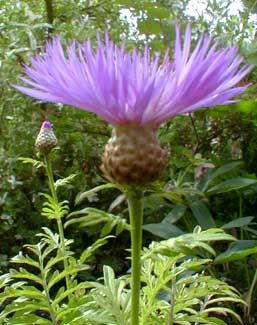
Persian Cornflower; aka,
Persian Bachelor Button; or,
Ornamental Knapweed
"Flowers are heaven's masterpiece."
-Dorothy Parker
(1893-1967)
(1893-1967)
Centaurea dealbata 'Rosea' is easily grown from seed in moist soil. It self-seeds a mite willfully, so should be deadheaded or it may well spread everywhere. Or it can be permitted to naturalize in a low-maintenance meadow-garden.
It is the same genus as the invasive knapweeds, but is not quite that aggressive; rather, this native of the Caucasus mountains is one of the more common perennial centaureas to be grown as decorative border-perennials, with several cultivars available, though the annual C. cerulea or Blue Bachelor Buttons is even more commonly gardened.
Some knapweeds are so invasive that they have spread world-wide, & are pest-plants throughout the United States. Within US borders, however, the Persian cornflower has naturalized only in the interior of Washington & Montana, & is nowhere notably aggressive.
It prefers a poor, sandy soil & is drought-tolerant once it gets its taproot down, after which point it will not transplant well, though division of an old clump isn't out of the question. Soggy winter soil will kill it, otherwise it'll be permanent to the garden.
The clump grows to eighteen inches high. Deeply cut foliage has silvery undersides. Showy rose-red thistle-like flowers occur May with rebloom throughout much of summer. It's liked by pollinating flies & butterflies.